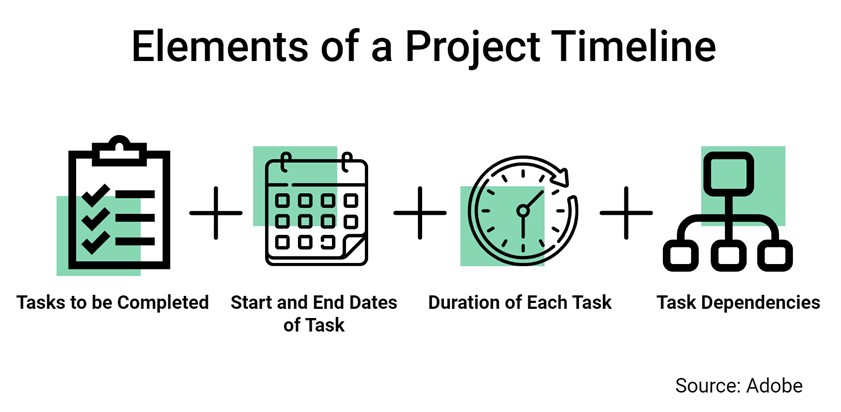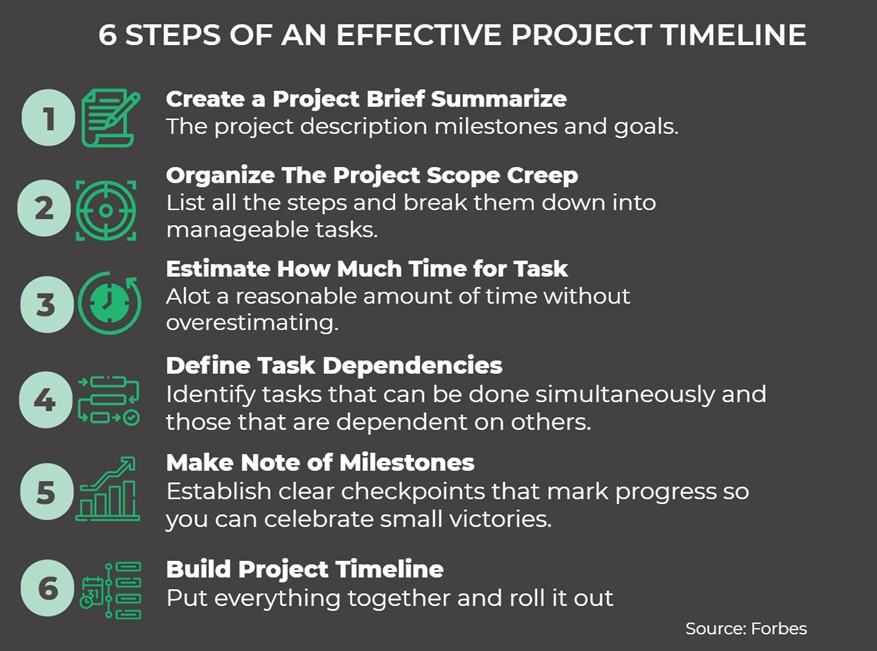
Have you ever witnessed the domino effect of a missed deadline in the fast-paced world of business? The team is thrown into disarray, progress stalls, and targets fall by the wayside. Essentially, the ball is dropped.
Could it be due to the lack of a clear project management timeline?
Indeed, the project management timeline is a cornerstone of effective project management and is a timeless practice that holds the key to success in a landscape undergoing profound transformation. As we invest a staggering $48 trillion globally in various projects annually, project managers emerge as the stalwarts of the corporate realm. Their unique blend of skills, from numbers to planning and people skills, is indispensable in a multitude of fields.
With artificial intelligence at the forefront of project management evolution, Gartner’s remarkable forecast indicates that by 2030, AI will manage a whopping 80% of projects. This transformative landscape calls for a moment of reflection, prompting us to question the indispensable skills required to navigate it.
In this digital era, harnessing modern business technologies—such as AI-driven analytics and cloud-based collaboration tools—empowers project managers to craft accurate, smart, and reliable project management timelines, ensuring that the pulse of progress beats in harmony with the demands of a rapidly changing business environment. So, let's embark on a journey through the world of project management timelines and explore the extraordinary influence of the project management timeline in this ever-evolving landscape.
Understanding the Project Management Timeline
A project management timeline is a visual depiction of a project’s lifecycle, encapsulating all its tasks, stages, and objectives. It delineates the project’s duration, pinpoints its requirements, and aids team members in comprehending their responsibilities. The timeline underscores the project’s completion date and the deadlines for each deliverable and milestone. Project managers can leverage it to streamline the planning process, elucidate team members’ roles and responsibilities, and monitor issues throughout the project.
This method further enables managers to allocate resources efficiently, manage budgets effectively, and pinpoint decisions that necessitate the green light from higher-level executives. It serves as a tool for prioritizing activities and steering team members towards supporting each other. Here are some common types of project management timelines:
- Gantt Chart - This horizontal bar chart organizes project phases and illustrates the dependency of certain activities on others for progression. It typically includes a task list, bars, datelines, notes, and assigned team members.
- Triple Constraint Timeline - This focuses on the project’s cost, time, and scope. Its objective is to aid in planning project tasks based on these three elements, resulting in realistic deadlines, cost estimates, and timeframes.
- Work Breakdown Structure (WBS) - This timeline breaks down the project’s primary activities into smaller, more manageable tasks. The WBS is a hierarchical list of activities that can be organized based on the project’s scope, objectives, priorities, and expectations.
- Critical Path Method (CPM) - The CPM aids in better identification of dependencies between project tasks and deliverables. It aims to prioritize urgent tasks and deliverables while indicating less critical ones.
A project management timeline does more than just list your projects; it visualizes all these factors for you. A clear visualization of your workload leads to better clarity, and greater clarity enhances your project management skills. Leveraging a project management timeline solution is an excellent option if you wish to visualize your project roadmap and future events.
Top 4 Reasons Project Management Timeline Is Important
A project management timeline is a visually appealing capability that succinctly communicates the project timeline to the client. This template enables diligent project managers to dissect and define the tasks required for the project, making it comprehensible for both the client and the production team, eliminating the need for separate documents.
Furthermore, a project management timeline aids in managing client expectations. Clients can view the dates and corresponding tasks currently being executed, providing them with an understanding of when to request updates or what to anticipate at a given time. Here are the pivotal reasons why project timelines are of paramount importance:
- Comprehensive Project Overview - Amidst the complexities of project implementation, it's easy to become entangled in the details. A project timeline provides a panoramic view, enabling your team to zoom out and grasp the sequence of various tasks. It fosters a context for team members to comprehend how their individual contributions interconnect, helping to pre-emptively identify potential obstacles and prerequisites.
Proactively identifying roadblocks before project commencement can significantly reduce project failure rates.
- Resource Management Excellence - Projects rely on a trifecta of resources: equipment, budget, and the valuable time of team members. In a perfect world, these resources would always be readily available. However, in reality, resource limitations often pose a significant challenge.
A well-structured project timeline plays a pivotal role in optimizing resource allocation. It provides clarity on when specific tasks are scheduled, allowing for efficient resource management. For instance, if your graphic designer's availability is constrained until the end of the month, you can proactively plan and allocate resources accordingly.
According to PMI’s 2018 survey, 21% of project failures were primarily due to resource constraints.
- Breaking Monolithic Projects into Manageable Steps - Tackling large-scale projects can feel daunting, much like the idea of disassembling a complex machine piece by piece. However, a project timeline provides a solution by breaking down monumental tasks into actionable steps. This approach offers a roadmap that enables your team to make gradual progress, ensuring that the project remains manageable without becoming overwhelming.
Incorporating a to-do list template can facilitate the organization of tasks, preventing an undue burden on the team and ensuring a structured approach to project completion.
- Ensuring Project Adherence - Perhaps the most significant advantage of a project timeline is its role in maintaining project alignment and steering it toward success. By decomposing the project into smaller components, it becomes easier to identify any gaps or inconsistencies, allowing for vigilant progress monitoring. The timeline also enhances accountability within the team, as everyone gains visibility into their respective responsibilities and deadlines.
As per a report by Atlassian, an overwhelming 91% of employees view accountability as a crucial aspect of their workplace, highlighting the importance of this degree of responsibility.
In summary, project timelines offer a holistic view of projects, optimize resource management, simplify complex endeavors, and foster accountability, making them an indispensable solution for successful project management.

How to Create a Project Management Timeline
In the realm of project management, a cohesive and well-structured project management timeline is an essential feature, fostering a collective spirit of determination while keeping your team on the organized path to success. However, the question that often perplexes many is, "How do you go about creating one?" Here is the process that underscores the importance of a proper project management timeline and how to go about creating one:
- Grasping the Project Scope - Let's consider the construction of a complex puzzle, one that initially appears to be a straightforward task. You're handed a box of puzzle pieces, and it may seem like completing it would take minimal time and effort. However, what if you're suddenly told that the puzzle comprises thousands of pieces, each intricately designed and requiring precise placement to form the complete picture? As you realize the intricacy involved, the importance of understanding your project scope becomes evident.
This analogy underscores the significance of comprehending your project scope, which encompasses all the elements essential for project completion, including tasks, timeframes, and resources. By comprehensively identifying project requirements from the outset, you can create a realistic timeline and proactively address scope creep. Remarkably, a staggering 52% of projects experience scope creep, making it a common challenge.
To define your project scope, you must pinpoint:- Goals - What is the ultimate objective of your project?
- Deliverables - What is the expected output of your project?
- Tasks and activities - What specific steps are necessary to produce the deliverables?
- Exclusions - What components will not be included in this project?
- Constraints - What limitations or constraints must be considered?
Once these aspects are determined, you can consolidate them into a project scope statement, that will serve as a reference point throughout the project. This clarity enables you to remain focused on the core aspects of your project while effectively managing additional requests.
- Identifying Project Tasks - A project timeline isn't merely about setting a single end date for the entire project; it involves establishing milestone dates for individual tasks throughout the project's lifecycle. This detailed breakdown is often referred to as a Work Breakdown Structure (WBS), which dissects the overarching project into various deliverables, simplifying the identification of associated tasks.
For instance, in the case of our complex puzzle project:
- Deliverable #1: Edges
- Sort out and assemble the edge pieces.
- Form the outer boundary of the puzzle.
- Deliverable #2: Puzzle Sections
- Sort and complete sections with similar colors or patterns.
- Keep these sections separate.
- Deliverable #3: Central Image Assembly
- Find the key points in the image.
- Combine completed sections into the central image for accuracy.
- Deliverable #1: Edges
And so on for other deliverables. This detailed approach makes it easier to recognize the tasks associated with each deliverable.
While jotting down tasks on paper might seem like an initial option, it’s important to remember that this method isn’t sustainable for team-wide access and collaboration. Instead, consider using collaborative knowledge-sharing platforms and predictive intelligence solutions. These tools not only store project details and responsibilities but also facilitate collective task tracking and completion. This digital approach ensures sustainability and enhances team productivity.
- Assigning Time Estimates to Each Task - Now that you've outlined your deliverables and their associated tasks, the next step is to determine the time required for each task. For this, evaluate each task and provide an estimated time for its completion. It's beneficial to involve your project team in this process as they offer a more realistic view of task durations, preventing the planning fallacy, which often leads to underestimating task completion times.
- Sequencing Your Tasks - With tasks and time estimates in hand, the next step is to arrange them logically. Consider task and resource dependencies, as well as concurrent tasks, to create a realistic and efficient timeline. For example, some tasks may rely on the completion of others, while certain tasks can be executed simultaneously to save time.
- Setting Deadlines - Time estimates alone don't constitute a comprehensive schedule; you must also assign concrete deadlines to each task. Instead of vague time frames, specify exact dates for task completion. To account for unforeseen challenges, it's advisable to build in a buffer, ensuring your project timeline remains robust and adaptable to surprises.
By following these steps, you'll be well-prepared to create a project management timeline that not only enhances your team's productivity but also safeguards your project from scope creep, leading to successful project completion.

Benefits of Project Management Timeline Solution
While it is possible to manage a project without a timeline, the use of project timeline software can significantly simplify the project management process. Here are some reasons why you should consider using one:
- Efficient Resource Management - Enables effective allocation and management of resources such as manpower, equipment, and materials.
- Proactive Risk Mitigation - Helps identify potential risks early on and take the necessary measures to mitigate them.
- Increased Team Accountability – Aids in clearly defining task dependencies and milestones, project timeline software enhances accountability among team members.
- Time-Saving Automations - Comes with automation features that can save project managers a significant amount of time.
A project management timeline provides project managers with greater visibility and control over their projects, making it an invaluable capability in the realm of project management.
Conclusion
In conclusion, project management timelines are the unsung heroes of successful project execution in a world where AI and technology are revolutionizing how we work. They offer a panoramic view, streamline resource management, break down complex endeavors into manageable steps, and foster accountability among team members. As the landscape of project management evolves, the timeless practice of creating effective timelines remains pivotal. To improve your project management timeline, think about incorporating predictive intelligence technologies for a more resilient and adaptable schedule. Utilizing AI and data analytics, predictive intelligence can lead to optimal project outcomes by identifying risks and opportunities and enhancing overall efficiency.
TrueProject, a leading solution in predictive intelligence, is designed to ensure the success of your project management timeline by providing a 360-degree view of project health. With features like Derived Insight, TrueProject analyzes early indicators of potential issues, enabling proactive adjustments to keep projects on track. The platform’s flexible monitoring with customizable dashboards and metrics-based research allows for informed decision-making and prioritization of critical tasks. By benchmarking against a repository of successful projects, TrueProject helps identify areas needing attention, ensuring that resources are allocated effectively, and risks are mitigated efficiently. Ultimately, TrueProject empowers teams with a robust project management timeline fostering better oversight and collaboration and driving projects toward guaranteed success.
More information on TrueProject at trueprojectinsight.com
About the Author:
Nisha Antony is an accomplished Senior Marketing Communications Specialist at TrueProject, a leader in predictive intelligence. With over 16 years of experience, she has worked as a Senior Analyst at Xchanging, a UK consulting firm, and as an Internal Communications Manager on a major cloud project at TE Connectivity. Leveraging her versatility, Nisha develops and executes strategic marketing campaigns across modern business technology domains. She is an insightful storyteller who creates engaging content on AI, machine learning, analytics, cybersecurity, governance, project management, cloud platforms, workforce optimization, and leadership. Nisha is a passionate professional, inspired by emerging tech innovations that transform businesses.
Endnotes
- Indeed Editorial Team. “How to Create a Project Management Timeline (With Example)” Indeed: August 18, 2023. https://ca.indeed.com/career-advice/career-development/project-management-timeline
- Adam Tan. “The Importance of a Project Management Timeline.” February 16, 2021. https://www.syntacticsinc.com/news-articles-cat/project-management-timeline/
- Atlassian Team. “Project timelines for improved project management.” Atlassian: (n.d.) https://www.atlassian.com/work-management/project-management/project-planning/timeline
- Project Manager Team. “What Is a Project Timeline?” Project Manager: (n.d.) https://www.projectmanager.com/guides/project-timeline
- Laura Hennigan & Cassie Bottorff. “How To Create A Simple, Effective Project Timeline In Six Steps.” Forbes: September 12, 2023. https://www.forbes.com/advisor/in/business/software/create-a-project-timeline/





